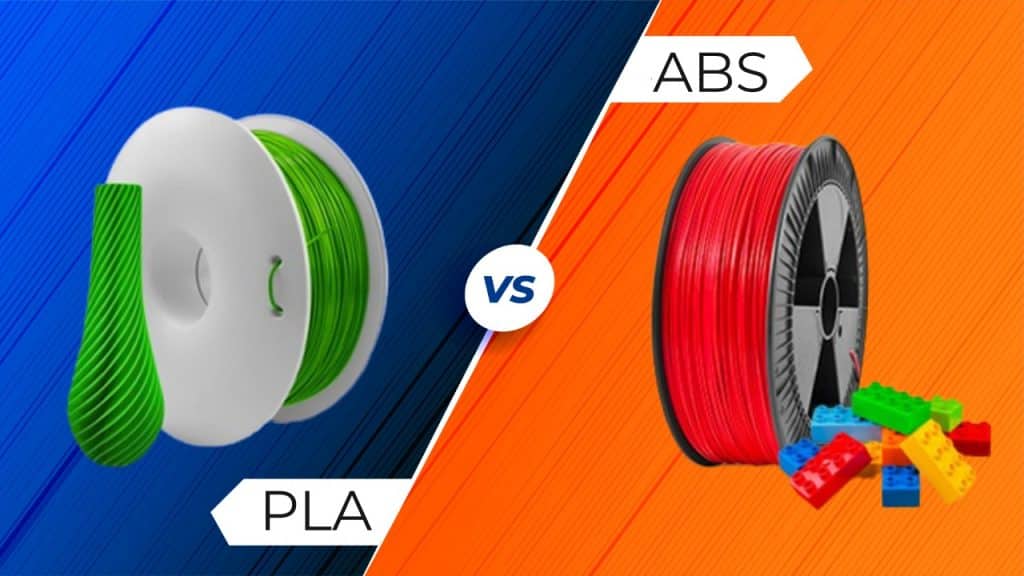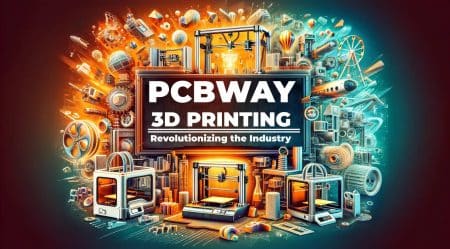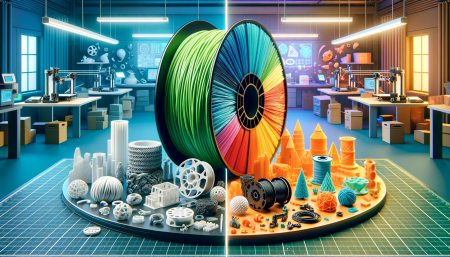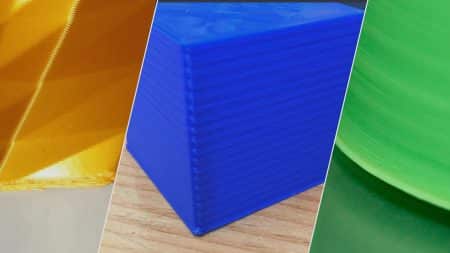It can be challenging to select a suitable polymer for 3D printing. This is true for all 3D printing technologies. Still, it can be difficult for beginners or hobbyists using FDM/FFF 3D printing to determine which filament is best. In the past, we described how the two 3D printing filaments, PETG and PLA, differ. We now want to take things further by contrasting PLA vs ABS, two of the most well-liked and frequently used filaments. We examined the characteristics, printing requirements, and other aspects of PLA and ABS in greater detail to help you decide which to use for your needs.
What Is PLA?

Polylactic acid is referred to as PLA. PLA is made from sustainable, organic materials like cornstarch and sugar cane set it apart from most other plastics. It can be produced at a much lower cost because it doesn’t rely on petroleum. In addition to lowering consumer prices, this lessens the environmental impact of PLA.
Furthermore, PLA deteriorates much more quickly than other plastics. Unlike PLA, which degrades entirely in two years, standard plastic bottles can take over a century to degrade. Despite this, it is still a good printing option, as discussed in the section below.
Characteristics Of PLA

The glass transition temperature of PLA is shallow. The temperature at which the filament becomes malleable is around 65 degrees for PLA. The good news is that printing with this material doesn’t require nearly as much heat or power. The bad news is that PLA cannot be used to print objects that must withstand heat for any significant amount of time.
PLA is quite sticky when heated because it is made with natural sugars. This is beneficial because it keeps your models from shrinking while you print and helps them adhere to the print bed. Additionally, the sugars emit an almost honey-like smell that adds a little extra pleasure to every print session. Because PLA is slightly more brittle than other materials, it has fewer uses overall. For instance, we wouldn’t create anything similar to a PLA striking hammer. It is better to use it as a general all-purpose plastic for various items like stationary holders or figurines.
What is ABS?
Another popular 3D printing filament is ABS (Acrylonitrile Butadiene Styrene). ABS can be recycled easily, despite not being as biodegradable as PLA. Making new ABS is one of the most popular uses for old ABS. Incredibly, life goes in a circle, isn’t it?
A favorite among hobbyists due to its adaptability is ABS. It is simple to paint and can even be repeatedly heated without burning. No problem if there is an edge that isn’t quite right. You can fix it by simply heating it up once more. What else distinguishes it from other materials, then?
Characteristics Of ABS

ABS has a higher glass transition point than PLA, around 105°C. This indicates that it’s a better option for printing heat-sensitive objects. Make a gearshift knob that won’t melt in your car on a hot day, for instance.
Another aspect that contributes to ABS’s popularity as a standard printing material. It is very tough. ABS is corrosion-resistant and much more likely to stretch than shatter. Because of its incredible tensile strength, it’s a fantastic option for anyone looking to sand, buff, or glue the finished product.
You should be aware of one thing, though. When cooled, ABS has a propensity to shrink quite violently. Because of this, it’s essential to ensure your printing area is adequately heated to prevent the product from shrinking excessively and cracking.
In contrast to PLA, ABS has a smell that can only be described as unhealthy. What’s this? This is due to how harmful the fumes are to you. Make sure to print in a room with good ventilation. We all know a warm, well-ventilated space. Unfortunately, achieving a more robust, more durable print comes at the expense of this delicate balancing act.
PLA vs ABS: Comparison in Characteristics and Properties

Naturally, the material that each is made of must be taken into account when discussing the advantages of PLA vs. ABS. The similarities between the two materials end there.
PLA vs ABS: Sustainability
However, they are both known as thermoplastics—polymers that can be heated to a soft state before cooling and hardening. ABS, like the majority of everyday plastics, is famously made from petroleum, unlike PLA, which is famously made from organic sources like corn or sugar cane. More specifically, PLA is created using fermented plant starch from sources like the pulp of sugarcane, sugar beet, cassava, or maize. These sources of sugar produce lactic acid, which is then polymerized to create polylactic acid.
In contrast, the monomers that makeup ABS are acrylonitrile, butadiene, and styrene. Butadiene is a petroleum hydrocarbon; acrylonitrile is a synthetic monomer made from propylene and ammonia, and styrene is produced by dehydrogenating ethyl benzene (removing hydrogen through a chemical reaction). It makes sense that the characteristics of these materials affect their “sustainability.”
Because PLA is biodegradable, it is frequently hailed as a more environmentally friendly material. Since PLA is made from renewable resources, it is undoubtedly more “green” than many other materials; however, when it comes to disposal, it may not be as green as it is frequently claimed to be. It’s essential to remember that many towns lack the proper equipment to degrade the material, and it is only genuinely biodegradable under the appropriate circumstances. This indicates that while it is technically feasible, in practice, it could only be accomplished through commercial composting.
On the other hand, ABS is not considered to be a sustainable or environmentally friendly material. As previously mentioned, it is made from petroleum, as are most plastics, meaning its processing is not as sustainable. However, a plus is that ABS is recyclable, though it is not widely accepted by recycling centers. Considering that many people do not realize how limited the biodegradability of PLA is, this could even be considered a plus for beginners who could be more sure that the plastic would be appropriately disposed of without creating more waste.
PLA vs ABS: Characteristics of materials
Beyond the fundamentals of the material, ABS and PLA also have unique qualities that set them apart from one another. The heat resistance of each one is one, which will also be considered when discussing printability. Namely, PLA melts at much lower temperatures and is not thought to be heat resistant, whereas ABS is heat resistant and has a higher glass transition temperature. This naturally affects how the materials should be applied, which will be discussed later. In general, you should pick ABS if you want a more durable material with better mechanical properties. In addition to having a higher heat deflection and being heat resistant, it is also impact resistant, more robust, and lighter than PLA. Even though the tensile strength of the two materials is comparable (ABS is slightly lower, though), ABS is frequently chosen for more industrial applications due to its improved flexibility, or a material’s ability to be deformed without breaking, as well as its higher flexural strength and better elongation before breaking. These indicate that PLA is more brittle than ABS, which is more flexible. Together, these factors make ABS suitable for end-use applications, which contributes to its appeal in sectors like injection molding.
However, PLA triumphs in a few additional categories. It is noteworthy that it is more rigid and more robust than ABS. Despite this, it loses these qualities above 50 degrees Celsius due to its low melting point, making it less useful in heat applications. Although ABS is significantly more heat resistant than PLA, both thermoplastics eventually degrade in heat and UV light because they are both thermoplastics. Therefore, different materials would be preferred for parts that will be outside.
Ease of Print
Following our discussion of the qualities and differences between PLA and ABS, we will discuss the 3D printing procedure. The print preparation will first differ because the glass transition temperature between the two thermoplastics is different. This is due to the need to consider the temperature range at which a thermodynamic transition in matter occurs. PLA’s glass transition temperature ranges from 60 to 100 oC, while ABS’s degrees from 105 to 200 C. This establishes the material’s melting point, or the point at which it will become liquid and be prepared for printing. The time needed to warm the 3D printer and reach the desired temperature will vary depending on the slicer’s settings.
Unlike PLA, which typically has a print bed temperature of 60oC, ABS requires a higher print bed temperature of about 80-110oC. In terms of the extruder, PLA also requires a lower temperature, specifically between 180 and 230 °C, as opposed to 210 to 250 °C for ABS. In connection with this, it is critical to correctly set the bed and print head variables of the manufacturing process.
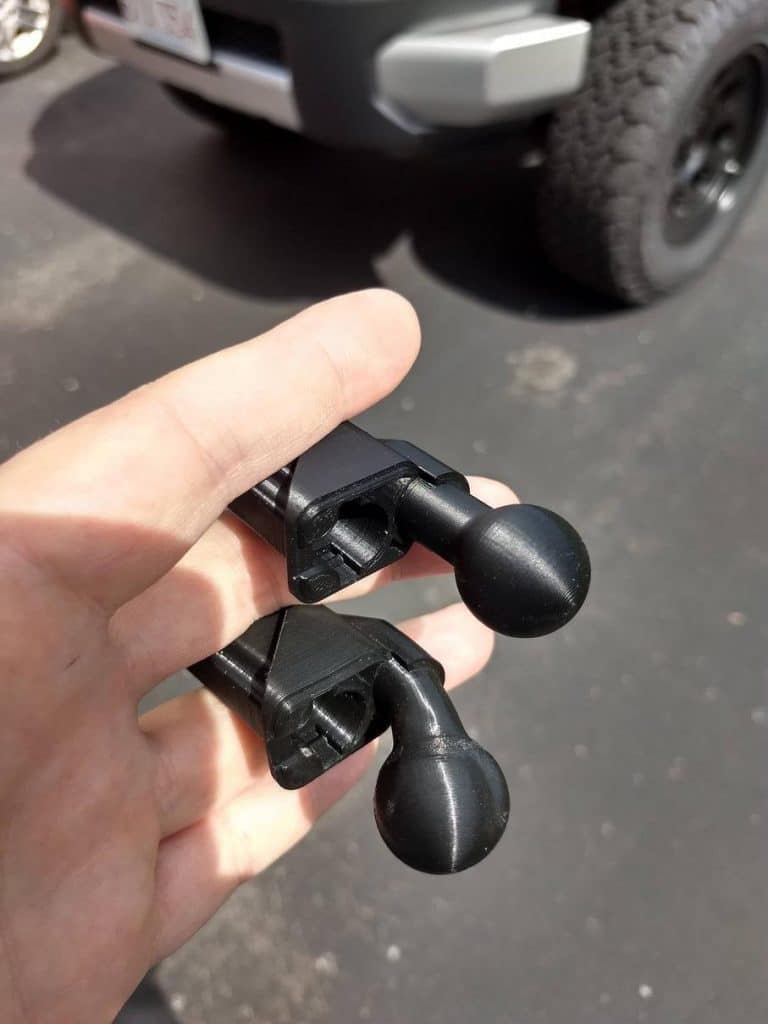
ABS is known to be more challenging to print with than PLA in terms of ease of use. The temperature and characteristics of each material also affect printing challenges. The thermal change required for the layers to solidify is less when PLA is used in 3D printing than ABS because PLA melts at a lower temperature. When cooling the parts, there will be a more abrupt change because ABS needs higher temperatures to melt. Parts that are misshaped as a result of this thermal shrinkage. In fact, warping, in which the part’s ends contract, separate from the tray, and deform, is one of the most frequent issues. When printing with ABS, it is essential to regulate the environment’s temperature and use adhesives to prevent this phenomenon. This is another justification for the frequent recommendation to use an enclosed chamber 3D printer when printing with ABS.
Advantageously, both materials print reasonably quickly because it eliminates the need to change the slicer’s parameters for the various materials. Although some users have even printed PLA at speeds higher than 60 mm/s, this is the standard printing speed. On the other hand, ABS is typically between 40 and 60 mm/s, and a higher rate would be challenging.
Fumes of filaments
The emissions produced during manufacturing are a further consideration during the process. Some of the noxious odors and gases produced during printing are more harmful than others, but this is true of nearly every thermoplastic filament. When the material is heated, toxic particles-containing substances are released. Since PLA is made from natural, plant-based sources, it does not have a strong smell and shouldn’t be a cause for concern. ABS is understood to release toxic gases and a disagreeable odor, though. In fact, this is yet another reason why it is strongly advised to use an enclosed print enclosure and an air filter when using ABS to prevent fumes from entering the workspace. And even then, it is recommended to constantly ventilate the space to avoid the fumes from getting into our lungs. This is because ABS contains styrene, which is toxic to humans when inhaled.
Finally, we conducted in-depth interviews with experts in the field to learn more about the characteristics and printability of both filaments. Marketing Manager Luke Taylor of Polymaker explained: “Although PLA is a weaker material, its advantage is that it is simple to work with and prints quickly. It has meager shrinkage rates, unlike ABS, which has a very high shrinkage rate, so you do not need a heated bed or high temperatures. And it makes sense because, generally speaking, we observe that the more complex something is to work with, the better its mechanical properties. Even so, there are things we can add to PLA to strengthen it without affecting its ability to be printed “.
Post-Processing

It is safe to say that similar post-processing methods can be applied to both thermoplastics when comparing PLA and ABS. Nevertheless, there are a few noticeable differences in the part’s post-printing finish. While ABS parts typically have a more matte finish, PLA parts are shinier right away after removal. After printing, both materials can be decorated with paint.
However, post-processing ABS is typically simpler than PLA. There are several reasons for this. First, even though both can be sanded, ABS is easier to work with due to its durability. PLA’s low heat resistance makes it easier to melt, making sand more difficult. Both materials can be machined, but PLA users must be more careful.
In contrast, ABS is not only simpler to post-process using these fundamental techniques, but ABS parts can also be smoothed with acetone vapor for a gleaming finish. Acetone is a colorless liquid that is frequently employed as a plastics solvent. Acetone can be used to post-process ABS parts much more quickly and give them a glossy finish, even though PLA cannot be used with it. However, using PLA, a similar procedure is still possible. If you want to vapor smooth parts made of PLA filament, you can use THF, or tetrahydrofuran, for hand polishing.
Applications for PLA vs ABS
Comparing PLA and ABS, the applications each material uses are another significant difference that we can identify. We can choose between the two depending on the proposed part’s function. The most popular 3D printing material for FDM is PLA, primarily used in maker spaces. This is mainly because it prints quickly and has mechanical characteristics that make the parts weak, fragile, and sensitive to the sun and high temperatures. Because of this, it is frequently utilized extensively by new users or in producing toys and decorative items.
On the other hand, the parts made from ABS have better qualities despite being more challenging to print because it is a more industrial material with advanced properties. As a result, it is frequently employed in creating prototypes, gears, or tooling. In short, it is typically used when high mechanical and thermal resistance is needed, and parts may be subjected to physical stresses. To produce parts appropriate for each material’s use, evaluate the differences between the two materials before beginning the additive manufacturing process.
Price
There is no functional distinction between PLA and ABS based on price. Instead, the cost varies depending on the manufacturer. Particularly when it comes to 3D printers with closed systems, manufacturers have a part to play. This indicates that the only filaments compatible with those printers are those produced by or acknowledged by the relevant manufacturer. This choice can affect the price but is frequently made to ensure quality control. The cost of ABS and PLA filament will still be comparable in a closed system, if not the same.
A primary filament roll generally costs around $20, but we discovered that 1 kg of PLA and ABS filament starts at about $18. Of course, the cost will increase significantly if you want higher-quality filaments or unique features like multicolor or professional grade. However, it should be noted that since PLA is probably the most widely used 3D printing filament, as was already mentioned, there tends to be a wider variety of colors and options available for PLA filaments. You can also find PLA filaments from most material or 3D printer manufacturers.
Although ABS filaments are sometimes more expensive than PLA filaments due to a lack of supply, this is the case when the materials are unprocessed. One of the most common industrial plastics, ABS, is less expensive as raw material or before being processed into a shape like a filament, as with companies like LEGO. Even though this has little bearing on FDM printers, it might be a consideration for those who use pellets because, in this scenario, ABS would probably be less expensive than PLA.
Manufacturers of the Materials

There are a lot of businesses in the additive manufacturing market that specializes in developing new materials. Most manufacturers create thermoplastic polymer filaments because FDM 3D printing is the most widely used technology by amateurs or commercial businesses. The offer is much more significant for PLA than for ABS because PLA is more widely used and democratic. Although ABS filament is also available in various brands and colors, the supply is less plentiful than PLA, even though there are now hundreds of different brands, colors, and blends. Regarding suppliers of PLA materials, businesses like Polymaker, ColorFabb, Filamentum, MatterHackers, etc., are devoted exclusively to the development of filaments.
If we concentrate on ABS, we can observe that companies that create this kind of filament also produce PLA. In this sense, we can find Polymaker, Hatchbox, or Filamentum. We also can’t forget about the machine makers, who spend some time creating 3D printing materials even though it isn’t their primary business. In this situation, it is essential to mention companies like Ultimaker, Zortrax, or Flashforge.
What do you think about the PLA vs. ABS comparison? Have you got a favorite material?



